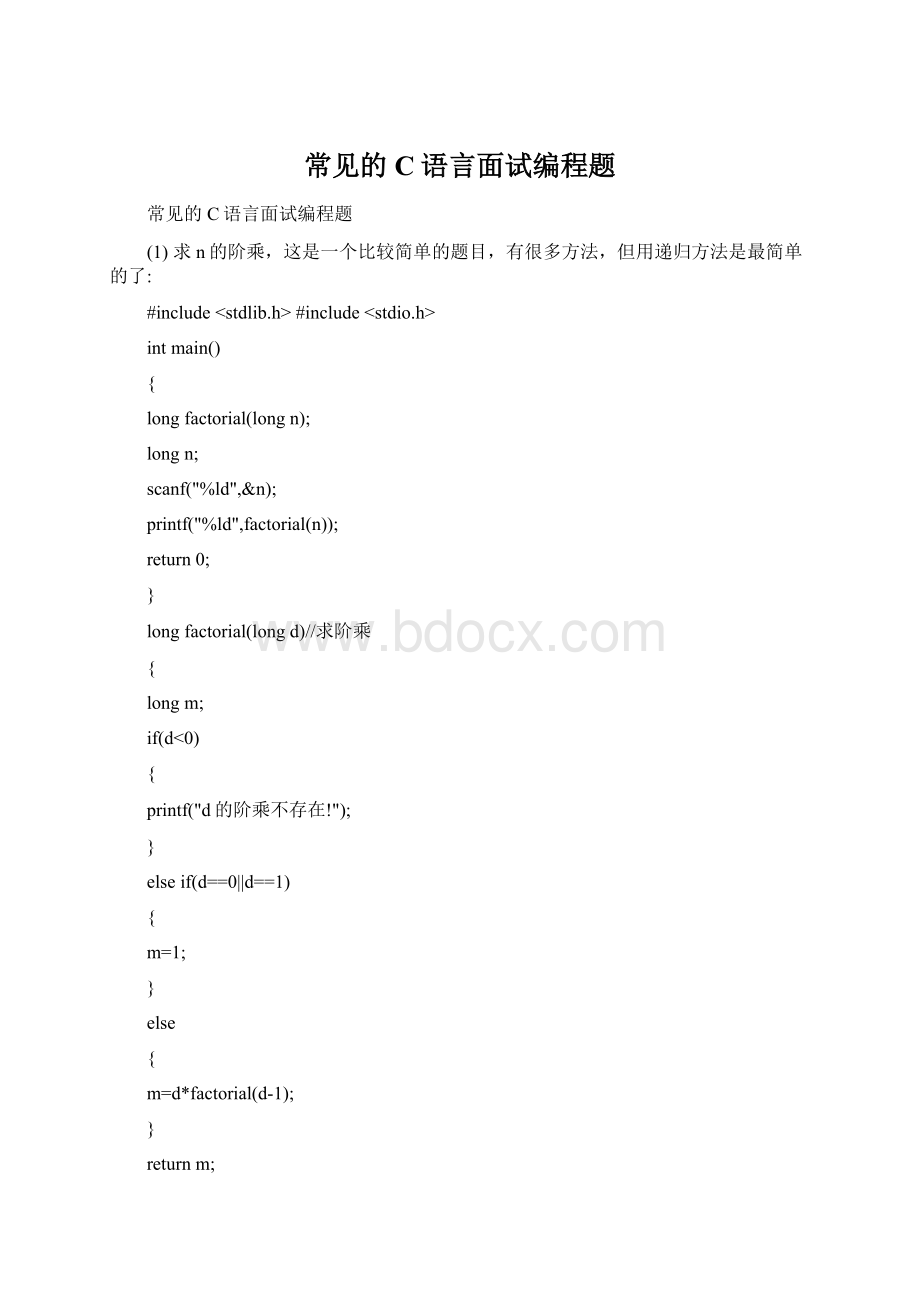 常见的C语言面试编程题.docx
常见的C语言面试编程题.docx
- 文档编号:4488227
- 上传时间:2022-12-01
- 格式:DOCX
- 页数:18
- 大小:16.67KB
常见的C语言面试编程题.docx
《常见的C语言面试编程题.docx》由会员分享,可在线阅读,更多相关《常见的C语言面试编程题.docx(18页珍藏版)》请在冰豆网上搜索。

常见的C语言面试编程题
常见的C语言面试编程题
(1)求n的阶乘,这是一个比较简单的题目,有很多方法,但用递归方法是最简单的了:
#include
intmain()
{
longfactorial(longn);
longn;
scanf("%ld",&n);
printf("%ld",factorial(n));
return0;
}
longfactorial(longd)//求阶乘
{
longm;
if(d<0)
{
printf("d的阶乘不存在!
");
}
elseif(d==0||d==1)
{
m=1;
}
else
{
m=d*factorial(d-1);
}
returnm;
}
(2)从一个文件读取整数,对其进行排序,然后再将排序的结果输入到原来文件当中,这
是一个经常考的题目,即考你的文件操作,又考了排序,我在这里用的是选择排序
#include
intreadtoarray(int*a,FILE*fp)//从文件里将整数读到数组里{
inti=0;
if(fp==NULL)
{
exit(0);
}
while(fgetc(fp)!
=EOF)
{
fscanf(fp,"%d",&a[i]);
printf("%d\n",a[i]);
i++;
}
returni;
}
voidwritetofile(inta[],FILE*fp,inti)//将数组写到文件里去
{
intk=0;
if(fp==NULL)
{
exit(0);
}
while(k { fprintf(fp,"%c%d",'',a[k++]); } } voidselectionSort(int*a,inti)//选择排序{ intm,n; inttmp,min; for(m=0;m { min=m; for(n=m+1;n { if(a[n] min=n; } tmp=a[m]; a[m]=a[min]; a[min]=tmp; } } intmain() { FILE*fp,*fpwrite; inti; inta[10]; fp=fopen("2.txt","r"); i=readtoarray(a,fp); fclose(fp); selectionSort(a,i); fpwrite=fopen("2.txt","w"); writetofile(a,fpwrite,i); fclose(fpwrite); return0; } 1,单向链表的插入,删除,逆序操作 #include #include typedefstructNode{ intkey; structNode*next;}*node; nodenewNode(intk){ noden=(node)malloc(sizeof(node)); n->key=k; n->next=NULL; returnn; } voidprintlist(noden){ if(! n) { printf("nisNULLlist\n"); } while(n) { printf("%d",n->key); printf(""); n=n->next; } printf("\n"); } nodenewList() { intk; nodehead=(node)malloc(sizeof(node));; scanf("%d",&k); if(k==0) { head=NULL; returnhead; } else { noden=newNode(k); head=n; while(k) { scanf("%d",&k); if(k! =0) { noden1=newNode(k); n->next=n1; n=n->next; } } n->next=NULL; returnhead; } } nodeinsertNode(noden,intp,intk) { noden1=newNode(k); nodehead=(node)malloc(sizeof(node)); head=n; if(head==NULL) { n1->next=head; returnn1; } else { if(p==1) { n1->next=head; head=n1; returnhead; } else { inti=2; while(i! =p&&(n->next)) { n=n->next; i++; } if(n->next==NULL) { printf("thepcan'tbefound\n"); returnhead; } else { n1->next=n->next; n->next=n1; returnhead; } } } } nodedeleteNode(noden,intk) { noden1=(node)malloc(sizeof(node)); nodehead=(node)malloc(sizeof(node)); head=n; if(head==NULL) { printf("listisNULL\n"); returnhead; } else { if(head->key==k) { head=head->next; returnhead; } while(n->key! =k&&n->next) { n1=n; n=n->next; } if(n==NULL) { printf("can'tfindthesamevalueaskinthislist\n"); returnhead; } else { n1->next=n->next; n=NULL; returnhead; } } } nodereverse(noden){ noden1[10]; nodehead=(node)malloc(sizeof(node)); noden2=(node)malloc(sizeof(node)); head=n; if(head==NULL) { returnhead; } else { inti=0; while(head! =NULL) { n2=head; head=head->next; n2->next=NULL; n1[i]=n2; i++; } head=n1[i-1]; for(intj=i-1;j>0;j--) { n1[j]->next=n1[j-1]; } returnhead; } } intmain() { noden=newList(); printlist(n); //插入操作 intk,p; scanf("%d,%d",&p,&k); nodenn=insertNode(n,p,k); printlist(nn); //删除操作 intq; scanf("%d",&q); nodend=deleteNode(nn,q); printlist(nd); //链表的倒置操作 nodem=reverse(n); printlist(m); return0; } 2,双向链表的插入删除操作 #include typedefstructNode{ intkey; structNode*pre; structNode*next; }*node; nodenewNode(inti){ noden=(node)malloc(sizeof(node)); n->key=i; n->pre=NULL; n->next=NULL; returnn; } nodenewduplinklist(){ inti; scanf("%d",&i); noden; if(i==0) { n=NULL; returnn; } n=newNode(i); nodehead=n; intk=1; while(k! =0) { scanf("%d",&k); if(k! =0) { noden1=newNode(k); n->next=n1; n1->pre=n; n=n1; } } n->next=head; head->pre=n; returnhead; } intsizeduplinklist(noden) {if(n==NULL)return0; nodehead=n; inti=1; while(head->next! =n) { head=head->next; i++; } returni; } voidprint(noden){ if(n==NULL) printf("此时链表为空! "); else { printf("输出链表: \n"); for(inti=0;i { printf("%-2d",n->key); n=n->next; } printf("\n"); } } nodeinsertNode(noden){ intp,k; printf("插入位置p: \n"); scanf("%d,%d",&p,&k); printf("\n"); if(p>sizeduplinklist(n)) { printf("此位置超出链表的长度! \n"); returnn; } elseif(p<1) { printf("此位置不存在! \n"); returnn; } else { noden1,head,m; m=newNode(k); head=n; if(p==1) { m->pre=n->pre; n->pre->next=m; m->next=n; n->pre=m; returnm; } else { inti=1; while(i! =p) { n1=n; n=n->next; i++; } n1->next=m; m->pre=n1; m->next=n; n->pre=m; returnhead; } } } nodedelNode(noden) { intp; printf("删除位置p: \n"); scanf("%d",&p); printf("\n"); if(p>sizeduplinklist(n)) { printf("此位置超出链表的长度! \n"); returnn; } elseif(p<1) { printf("此位置不存在! \n"); returnn; } else { noden1,head; if(p==1) {head=n->next; n->pre->next=n->next; n->next->pre=n->pre; returnhead; } else { head=n; inti=1; while(i! =p) { n1=n; n=n->next; i++; } n1->next=n->next; n->next->pre=n1; returnhead; } } } intmain() { noden=newduplinklist(); printf("%d\n",sizeduplinklist(n)); print(n); nodem=insertNode(n);print(m); nodem1=delNode(m);print(m1); return0; } 3,栈操作,用数组实现的包含出栈,入栈的操作 #include typedefstructSta{ inta[20]; intnum; }*sta; staNullStack() { stas=(sta)malloc(sizeof(sta)); s->num=0; returns; } stapushstack(stas,inti) { s->a[s->num]=i; s->num=s->num+1; returns; } stapopstack(stas){ if(s->num==0) { printf("stackisNULL\n"); returns; } s->num=s->num-1; returns; } voidprintstack(stas){ if(s->num==0) { printf("stackisNULL\n"); } else { for(inti=s->num-1;i>=0;i--) { printf("%d\n",s->a[i]); } } } intmain() { stas=NullStack();s=pushstack(s,1);s=pushstack(s,2);printstack(s); s=popstack(s); s=popstack(s); printstack(s); return0; } 4,队列操作,类似于栈, #include typedefstructQue{ inta[20]; intnum; }*que; queNullQueue(){ queq=(que)malloc(sizeof(que)); q->num=0; returnq; } queenq(queq,inti){ q->a[q->num]=i; q->num=q->num+1; returnq; } quedeq(queq) { if(q->num==0) { printf("queueisNULL\n"); returnq; } for(inti=1;i { q->a[i-1]=q->a[i]; } q->num=q->num-1; returnq; } voidprintqueue(queq){ if(q->num==0) { printf("queueisNULL\n"); } else { for(inti=q->num-1;i>=0;i--) { printf("%3d",q->a[i]); } } } intmain() { queq=NullQueue();q=enq(q,1); q=enq(q,2); q=enq(q,3); q=enq(q,4); printqueue(q); printf("\n"); q=deq(q); //printf("%d",s->a[0]); //q=deq(q); printqueue(q); return0; }
- 配套讲稿:
如PPT文件的首页显示word图标,表示该PPT已包含配套word讲稿。双击word图标可打开word文档。
- 特殊限制:
部分文档作品中含有的国旗、国徽等图片,仅作为作品整体效果示例展示,禁止商用。设计者仅对作品中独创性部分享有著作权。
- 关 键 词:
- 常见 语言 面试 编程
 冰豆网所有资源均是用户自行上传分享,仅供网友学习交流,未经上传用户书面授权,请勿作他用。
冰豆网所有资源均是用户自行上传分享,仅供网友学习交流,未经上传用户书面授权,请勿作他用。


 广东省普通高中学业水平考试数学科考试大纲Word文档下载推荐.docx
广东省普通高中学业水平考试数学科考试大纲Word文档下载推荐.docx
 《支部书记讲党课》PPT文件格式下载.pptx
《支部书记讲党课》PPT文件格式下载.pptx
